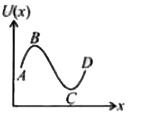The potential energy for a force filed →F is given by U(x,y)=cos(x+y). The force acting on a particle at position given by coordinates (0,π/4) is
1
√2
1√2
0
The correct Answer is:A
Step by step video, text & image solution for The potential energy for a force filed vecF is given by U(x,y)=cos(x+y). The force acting on a particle at position given by coordinates (0, pi//4) is by Physics experts to help you in doubts & scoring excellent marks in Class 11 exams.
Updated on:21/07/2023Topper's Solved these Questions
- WORK, ENERGY AND POWERBOOK - PHYSICS GALAXY - ASHISH ARORACHAPTER - WORK, ENERGY AND POWEREXERCISE - unsolvedMCQ
78 Videos
- WORK, ENERGY AND POWERBOOK - PHYSICS GALAXY - ASHISH ARORACHAPTER - WORK, ENERGY AND POWEREXERCISE - unsolved
1 Videos
- WORK, ENERGY AND POWERBOOK - PHYSICS GALAXY - ASHISH ARORACHAPTER - WORK, ENERGY AND POWEREXERCISE - Discussion Question
31 Videos
- RIGID BODIES AND ROTATIONAL MOTIONBOOK - PHYSICS GALAXY - ASHISH ARORACHAPTER - RIGID BODIES AND ROTATIONAL MOTIONEXERCISE - Unsolved Numerical
63 Videos
Similar Questions
Knowledge Check
The potnetial energy for a force field →F is given by U(x,y)=cos(x+y). The force acting on a particle at the position given by coordinates (0,π/4) is
A−1√2(ˆi+ˆj)B1√2(ˆi+ˆj)C(12ˆi+√32ˆj)D(12ˆi−√32ˆj)The potential energy of a force filed →F is given by U(x,y)=sin(x+y). The force acting on the particle of mass m at (0,π4) is
A1B√2C1√2D0The potential energy of a force filed →F is given by U(x,y)=sin(x+y). The force acting on the particle of mass m at (0,π4) is
A1B√2C1√2D0
The potential energy of a particle varies with distance x as shown in the graph. The force acting on the particle is zero at

View SolutionThe potential energy of a particle varies with distance x as shown in the graph. The force acting on the particle is zero at

View SolutionThe potential energy of a particle oscillating on x-axis is given as U+20+(x−2)2. The mean position is at
View SolutionThe potential energy of a particle is given by formula U=100−5x+100x2,whereU and are .
View SolutionThe potential energy of a body is given by U=A−Bx2 (where x is the displacement). The magnitude of force acting on the partical is
View Solution
